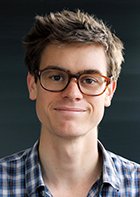International postdoctoral grant to Martin Speirs
The Independent Research Fund Denmark is investing just under DKK 22 million this year in 16 younger researchers' careers and original ideas, which have the potential to grow significantly in an international research context. One of the 16 is Martin Speirs, PhD from the Department of Mathematical Sciences at the University of Copenhagen.

Martin finished his PhD in November 2018, with Professor Lars Hesselholt as supervisor. He then went to the Mathematical Sciences Research Institute in Berkeley, as a postdoc. He stays in town, but now at the University of California, Berkeley:
- The DFF grant gives me a two-year employment at the University of Berkeley, with Martin Olsson as a mentor. Martin Olsson is one of the leading figures in arithmetic geometry, which is an important component of my project. It is a field I intend to include more in my research. In addition, the grant allows me to travel to international conferences, as well as to invite researchers for shorter stays at Berkeley, Martin says.
Topological cyclic homology
Martin's research project is called "Motivic Structures in Topological Cyclic Homology". According to Martin, topological cyclic homology (TC) is historically closely related to Danish research:
- It was Ib Madsen and Marcel Bökstedt (professor at Aarhus University) who, together with Wu-Chung Hsiang (Princton), invented TC in the early 90s. Lars Hesselholt did his Ph.D. with Ib Madsen as supervisor and then continued - together with a number of other researchers - the study of this exciting tool.
- A few years ago Peter Scholze (Bonn) and Thomas Nikolaus (Münster) made a breakthrough in the field, which has led to a number of new ideas and applications. These are some of the ideas that form the basis of my project, says Martin.
Natural numbers and cohomology theories
From the project description:
“The natural numbers have existed for as long as humankind, and yet there are many unanswered questions about them. For example it is still not known exactly how the prime numbers are distributed among the natural numbers — their distribution seems random and chaotic, while also exhibiting a wealth of patterns.
“To study these phenomena it is useful to study objects called zeta functions. A central discovery of 20th century number theory is that properties of zeta functions may be captured by a “measuring rod” called a cohomology theory. There are many different types of cohomology theories and this project is concerned with a new method of gaining insight into these. The approach is to use methods and ideas coming from topology.
“Topological cyclic homology (TC) is an example of a cohomology theory coming from topology. The special property of TC is that it contains information about many other cohomology theories, making it a very interesting tool.
“In my project I study a particular way of partitioning TC, called the motivic filtration. The motivic filtration is currently only understood when the underlying space is non-singular. However, singularities often arise in number theory, so the first of goal of the project is to extend our knowledge to this broader context. The second goal of the project is to turn TC into a more flexible tool by constructing a six-operations formalism in this setting”.
 Read more about DFF's International Postdoctoral Grants in Danish
Read more about DFF's International Postdoctoral Grants in Danish
Topics
Project details
Project:
Motivic Structures in Topological Cyclic Homology
Project period:
2019 - 2021
Funding:
The Independent Research Fund Denmark
Contact:
Martin Speirs
Email: speirs@math.ku.dk
Web: https://speirs.sites.ku.dk/
